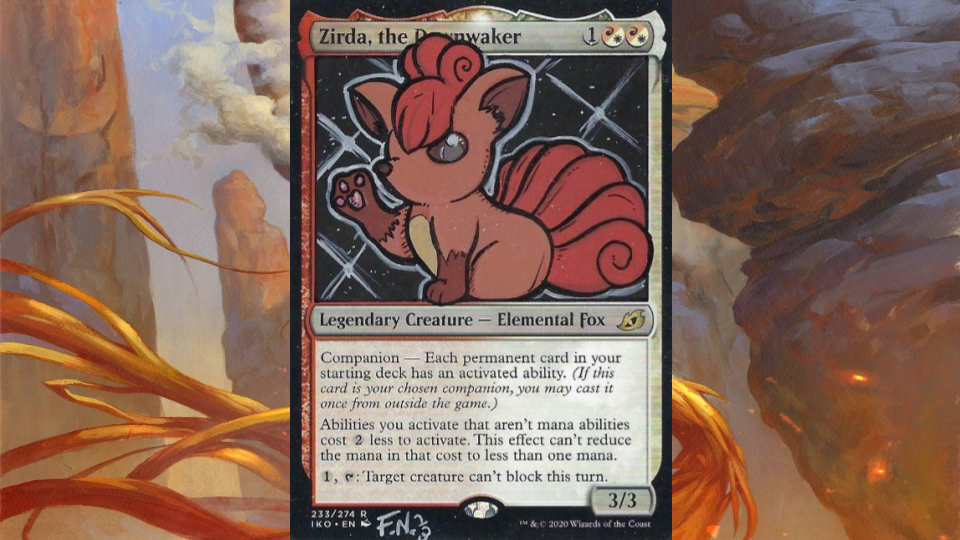Pokedecks: Zirda the Vulpix

Spellshifting Every Spell, from A to Zirda!
Last article, we followed up Jiwari Earthquakes with another unusual typal deck: Hamza Elephants. Chucking earthquakes was succeeded by stampeding pachyderms for an incredible 1-2 punch. This week, we'll look at my favorite grossly underrepresented typal deck: Spellshapers! Today's deck salutes a creature type that can do anything, transforming the cards in our hand into limitless possibilities!
The deck makes Spellshapers, one of the coolest creature types out there. Spellshapers specialize in "casting" iconic spells via their activated abilities, in a way that Garth One-Eye
I love typal decks because they simplify Rule Zero conversations and catch peoples' attention who might not know me, the commander, or even the game of Magic in general. You don't need to know those things to root on a Spellshaper deck; you just need to find what they do cool! I've run typal streams; I have a typal podcast (Quote of Arms), and I've even run a casual 16-person typal tournament, with $20 donated to charity in each podwinner's name, and gifting a Cavern of Souls
There are plenty of well-known and well-supported typal decks out there: Elves, Dragons, and Goblins are among those typically supported in main sets, with others getting more and more love over the years. There are others, however, where there hasn't been a lot of official support, especially when members of the type are printed sporadically and do not synergize with one another. This is where the challenge comes in: how can the deckbuilder MAKE the flavor of the type come across?
Interestingly enough, the PokeAlter would combine Fox's signature animal, my love of Pokemon, the type of animal Zirda is, and a rarely-used Gen 1 Pokemon move that simulates what Spellshapers do! Vulpix is a fire-type Fox Pokemon, which works with the red in Zirda's identity and the Fox typing that Zirda has. It also learns a move called Mimic in Gen 1, which copies a move, including one the Pokemon usually can't learn. How do we get these pieces to fit together into a cohesive build?
Zirda's Abilities
Zirda is a somewhat strange choice as commander for a Spellshaper deck, as Zirda isn't a Spellshaper, doesn't put cards in hand to shape, and two of the three abilities aren't all that helpful. As a commander, Zirda loses the value of being a Companion, but also loses the restriction. The creature-tapping ability is nice, but it, again, doesn't do anything to work with Spellshapers. What does work with Spellshapers, however, is the cost reduction on activated abilities. This both makes it easier to activate multiple abilities in one turn and to dump mana into some of the more expensive ones.
Heartstone
Fires of Invention
Battlemage's Bracers
Vulpix's Moves
The first generation of Pokemon was a wild place, with Pokemon able to learn a variety of questionable moves and moves that changed functionality or outright disappeared between generations. One of the moves Vulpix learns in Gen 1 that changes in subsequent Gens is Mimic. In Gen 1, Mimic allows the user to choose a move the opponent knows and use that move, but it has the power points of the Mimic move instead of what it copied. This ability to choose a move and get it to function multiple times instead of once is similar to Spellshapers using the abilities of instants and sorceries, but over and over by discarding cards instead of once and done.
Devout Witness
Latulla, Keldon Overseer
Seismic Mage
So...we've got repeatable utility spells and a solid way to win the game, but how do we make sure to have the hand size or Power Points needed to use the Spellshapers?
The Perfect Fusion
Spellshapers need to have cards in hand to shape into spells, and it's preferable that those not be spells themselves. As a result, cards that can add numbers to the hand size but not quality cards, as we will be providing the quality by shaping them into spells, are valuable. Thankfully, white's unique brand of pseudo-ramp does the trick!
Land Tax
Ah, the original Tithe
Gift of Estates
Zirda, Use Mimic!
Here is the most recent iteration of the deck, which is still one of my favorites.
What are some of your favorite typal decks? And how might you build some underrepresented ones? Also, what instants and sorceries would you like to see attached to a Spellshaper?